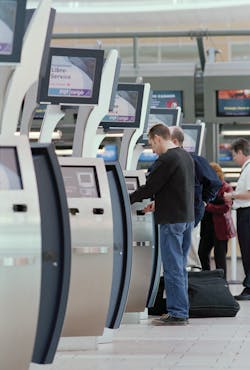Airports today are investing more financial resource into technology than ever before, and the spend will only increase. As technology has advanced, airport information technology (IT) departments have become the backbone of the business, supporting systems and processes that reach all areas of operation.
The investment in technology has become critical in improving the overall safety and security of the airport enterprise; in enhancing productivity and efficiency; in cutting costs and increasing revenue; and in facilitating the passenger experience.
New, emerging technologies offer a myriad of opportunity at the airport setting, and the challenge of integration, centralization, and general management and maintenance of IT suppport is top-of-mind as airports look toward the future.
Comments Kevin Molloy, VP of simplified passenger travel and CIO at Vancouver International Airport (YVR), "The progressive airports view IT as a game changer. It’s not just another service you provide, but you actually have the ability to radically affect how your business operates."
Dominic Nessi, CIO and deputy executive director for the Los Angeles World Airports (LAWA) relates that as airports have invested dollars over the years into networks and consolidated servers and data centers, it became apparent more and more that there was a need for an organization that pulled all of it together.
"Even though IT has become a more critical aspect at airports, the IT organization itself has not risen within the organization commensurate with that level of responsibility," he adds. "That will be a big challenge for IT organizations over the next ten years ... how do they become integrally involved with planning at the senior level?"
The Rise Of Airport IT
YVR has some 50 people that support the IT operation, says Molloy. Of those 50, some 25 are with the airport authority; the rest are employees of ARINC as part of an outsourced contract for support; ARINC has a 24/7 presence at the airport.
"When I add up all of our expenditures, it fits into three different categories — our capital budget (buys new or replaces existing), our operating budget (pays for annual contracts and warranties, and various telecom services), and our salary budget — added up, IT gets about 90 percent of the corporate revenue," says Molloy.
"IT is our third largest cost center, behind maintenance and field operations. Our funding has changed radically. When I joined the airport 17 years ago, technology investment was at the low end … airports seemed to be in the 2-3 percent range; some industries such as the financial sector were in the 9-10 percent range."
"I think that has evolved greatly ... airports were sort of passive landlords, and the airlines ran the day-to-day operation. Much of the technology was provided by airlines, and the government provided all of the screening and border control technology. Today, airports have moved into that space."
Maurice Jenkins, division director of information systems and telecommunications at Miami International Airport (MIA) remarks, "When I got here, it was coaxial cable, 8-inch Displaywriter systems … today, it’s mostly a client-server environment, mid-range systems.
"We’ve have invested greatly within our airport infrastructure for technology, and we are just wrapping up our $6 billion capital program … roughly $300+ million of that was IT."
MIA has some 120 employees directly related to technology; the airport's IT-related budget is in the 10-15 percent range, or some $22 million.
Los Angeles International Airport's (LAX) IT department includes 180 employees. Nessi says the airport has added fifteen positions in the past five years, but also employs a large amount of contract support.
The biggest challenge for airport IT today, says Nessi, centers around mobility, and technology convergence. "Convergence of a lot of different hardware and software, such as GIS (geographic information system) converging with mobile devices, is an increasing trend.
"Another challenge for airports particularly in the U.S. is standardization, and to all be doing something the same way. European Union airports have gone into a mode called collaborative decision making (CDM); I think that is something that we can do better in the U.S."
Nessi relates that LAX has an IT governance committee, which includes all the deputies of the airport. "That is another new direction that airports should be following — to actually govern IT at the highest levels of the organization," he adds.
"At a recent meeting, topics included: truck digital radios; a request for the new A SDE-X ground radar to be implemented; a parameter intrusion detection concept of operations; and e-Discovery for email archiving.
"Think about those four themselves … they are so varied in what they are doing, but they are expansive projects, and they touch every aspect of everybody."
The Further Extension Of Self Service
Molloy says there will be a few things happening in the next couple of years that will enhance self-service passenger processing. The first is biometric passports and travel documents. "A lot of the things we are constrained from doing today are due to security concerns," he says.
"What we are about to see coming down the pipeline is biometric technology, where your face is imbedded on a chip in the passport, and a kiosk can verify your identity.
"That allows the airport to go further in bringing services to the passenger. For example, it may allow us to treat the concierge at a local hotel as an airport agent, and to have the concierge accept bags from passengers going to the airport … and the airport authority could have trucks that pick up baggage form various hotels and convention centers, and we would offer this baggage-drop service on a permanent basis on off site locations.
"Even now, the new terminal in Las Vegas is supplemented with some 17 different off site check-in locations."
Molloy says the 'simplified travel' part of his title means to essentially work with his business partners to bring innovation and automation to them.
"And it is an incentive for airline partners to continue to do business here. The couple million dollars on self-service technology as opposed to the $100 million facility expansion, at the end of the day, the airlines get the bill for all of that — now they are getting smaller bills."
Domestically, some 80 percent of YVR's passengers are printing their own bag tags at the airport.
Jenkins agrees, stating, "I am looking at collaboration wherever I can. When KLM was here, some 94 percent of its passenger processing was done by self-service devices. So it’s key; it’s critical for us.
"You’re hearing a lot about NFC (near field communications) … Japan’s Narita airport uses it a lot for domestic flight boarding; it’s all NFC-based. You simply swipe your mobile device to board; it doesn’t have to be on.
"We are also looking at self-boarding … because the airport has the ability today to, if an airline uses part of the integrated paging system — thanks to the integration with Air IT and the AODB (airport operating database), and what we have with CUTE and SITA, the airline can set up automated audible announcements to facilitate the self-boarding process.
"That could allow a carrier to have one gate agent as opposed to three. We have some carriers using some of that functionality now."
The Cybersecurity Threat
Cybersecurity has become one of the most top-of-mind issues of the day, relates Molloy. "We have not seen anyone breach through all of our layers of security, but we have seen probes. We know the nature of the threats, but we don’t know the details.
"So what keeps me awake at night? For me, that fits into two categories. One is more related to complexity, and that is — the complexity of our technical environment is exceeding the complexity of our IT support team.
"It’s very hard with this diversity to keep a small team abreast of all technology at all times. Innovation and business cycles are measured in months, not in years anymore. Are we going to get ahead of ourselves? Are we going to put in so many solutions that we can’t actually sustain them."
And two, he adds, is the increased number of threats, and the increased capabilities in the cybersecurity space.
LAX's Nessi says cybersecurity today is almost demanding a more centralized IT operation. "What it really comes down to is you want to have separate cybersecurity staffs with different protocols and different policies," he adds.
Says Jenkins, "I am averaging more than 5 million attacks per month. From a bandwidth and data intrusion perspective, given the applications we support, I have several individuals completely dedicated to ensuring the support and maintenance of the security and integrity of this airport.
"We conduct ongoing training for our user community with regard to things to look for from a cybersecurity perspective. So we secure, we resecure, and at the end of the day, we resecure again."
Technology Firsts At YVR
Vancouver Airport Authority is considered a leader in the area of simplifying passenger travel. Since 1996, the Authority has continually introduced innovative programs that have enhanced the ease and speed of transit through its terminals.
Following is a timeline of travel innovations spearheaded at Vancouver International Airport (YVR):
1996 — Common Use Terminal Equipment (CUTE)
When YVR’s new domestic terminal opened in 1996, the Airport Authority introduced CUTE, permitting airlines to share hardware and plug in to the airport’s host computers. As a result, the airport significantly reduced the amount of facility space that was required for growth.
2001/2002 — Common Use Self-Service (CUSS) Check-in
In 2002, YVR was the first airport in the world to introduce CUSS check-in kiosks. Developed in conjunction with Air Canada, the movement set the international standard for self-service check-in processes.
2003 — On Board Check-in
In partnership with its cruise line and airline industry partners, YVR set a new cruise ship industry standard introducing a service where airline boarding passes are delivered directly to the cabin of cruise ship passengers, and baggage is tagged on board the cruise ship and delivered directly to the airport.
2007 — CUSS Baggage Check-in
YVR expanded CUSS and became among the first airports at which domestic passengers have the option of printing their own luggage tags.
2012 — Automated Border Clearance (ABC)
Most recently, and in partnership with Canadian Border Services Agency, the Airport Authority applied self-service technology to the border clearance process.
About the Author

